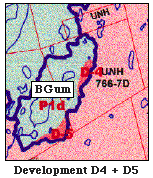
3.Preserve Area P1d Showing "Sensitive Development Areas 4 and 5"

a. Proximity of the Planned Development Area to a Specific Wetland Preserve Area P1d is the entire watershed of the Black Gum swamp. The swamp itself is labed BGum and its boundaries are outlined by a thin light-blue line. The watershed boundaries of the swamp are delineated by a thick dark-blue line. "Sensitive Development Areas D-4 and D-5" would be located nearly completely within the watershed of the Black Gum Swamp, and in fact, would be very close to the swamp itself.
b. Significance of the Black Gum Swamp The Black Gum swamp exists in a shallow depression in the southeastern part of the Hackett Hill property. A stream flows between the trees and allows the swamp to maintain moist conditions.
The black gum trees (tupulo trees) located in this swamp include the oldest tree (over 450 years old) in the state of New Hampshire. Also included in this habitat is the pitcher plant, a carnivorous plant of special concern.
With respect to the "New Hampshire Method" criteria for evaluating wetlands worthiness, the swamp was ranked high in "visual quality", "high flood control potential", and "educational potential". It was also ranked high in "noteworthiness", primarily because it has a state listing of S1 and S2. These listings indicate sites that are critically imperiled/imperiled due to the rarity and vulnerability of the species that inhabit them. The swamp is also considered noteworthy because it is appropriate for scientific research and because there are many vernal pools and seeps located in this region.
c. Harm of Planned Development The location of these planned development sites clearly imperils the Black Gum Swamp since two development areas would be located in close proximity to one another, and well within the watershed itself. Also, since there is no true road which connects this area and the exterior of the property, a road must be built to reach it . The extensive construction planned for this part of the Preserve could result in disturbances which could change the characteristics of the ground water and/or running water entering the Black Gum Swamp. In particular, the extent of the paved areas and their extremely close proximity to the swamp could increase the likelihood of contaminant-carrying run-off entering the wetland.
BACK TO PRESERVE-DEVELOPMENT MAP